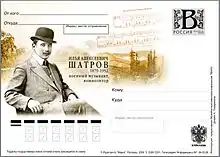Ilya Shatrov
Ilya Alekseevich Shatrov (April 1, 1879 (or 1885) - May 2, 1952) was a Russian military musician, conductor and composer, known for composing the waltz On the Hills of Manchuria in 1906, recounting his experiences at the Battle of Mukden during the Russo-Japanese War, which he dedicated to one of his comrades fallen at the battle.[1]
Ilya Alekseevich Shatrov | |
|---|---|
 Postcard issued for the 130th anniversary of Shatrov's birth | |
| Native name | Илья (Илий) Алексеевич Шатров |
| Born | April 1, 1879 (or 1885) Zemlyansk, Russian Empire |
| Died | Tambov, Soviet Union May 2, 1952 |
| Buried | Vozdvizhensky Cemetery |
| Allegiance | |
| Service/ | |
| Rank | Kapellmesister |
| Unit | Mokshansky Regimental Orchestra (214th Reserve Mokshan Infantry Regiment) |
| Battles/wars | Russo-Japanese War: |
| Awards | |
Biography
Shatrov was born in Zemlyansk, Semilukskiy, Voronezh Oblast, Russia on 1 April 1879 to Aleksej Mihajlovich Shatrov,[2] a retired non-commissioned officer of the Lithuanian Life Guards Infantry Regiment of the Russian Imperial Guard.[3]
In 1905, Shutrov became the bandmaster of the Mokshansky Regimental Orchestra and served in the Russo-Japanese war. In February 1905, the 214th Reserve Mokshan Infantry Regiment took part in the Battle of Mukden and Liaoyang. In one of the battles the regiment was surrounded by the Japanese and was constantly attacked by the enemy. At a critical moment, when the ammunition was already spent, the regiment commander Colonel Pavel Pobyvanets gave the order: "The banner and the orchestra will go ahead!" Kapellmeister Shatrov led the orchestra to the parapet of the trenches, gave the order to play a battle march and led the orchestra ahead of the regiment's banner.[4] Encouraged soldiers rushed into the bayonet attack. During the battle, the regiment, with the music of the orchestra, continuously attacked the Japanese and, in the end, broke through the encirclement. In the course of the battle the regiment commander perished, and of the original 4000 members of the regiment only 700 people, including 7 musicians of the orchestra, were left alive.[4] For this feat, all the survivor musicians of the orchestra were awarded with crosses of St. George, Shatrov - an officer order of Saint Stanislav 3rd class with swords (the second such awarding of the conductors), and the orchestra was awarded silver pipes.[3]
After the end of the Russo-Japanese War, the Mokshan regiment remained for a whole year in Manchuria, where Ilya Alekseevich, once on the orders of the new regiment commander at the guardhouse, began to write the waltz “Moksha Regiment on the Hills of Manchuria”, dedicated to the dead comrades. At first, the audience rather coolly met this waltz, but a year later gramophone records with his recordings became very popular. First published in 1907, waltz sheet music was reprinted 82 times by 1911. After 1911, the name of the waltz was reduced, it began to be called "On the hills of Manchuria" [1].
Having fallen in love with a young girl, Alexander Shikhobalov, Shatrov wrote the waltz “Country Dreams”, which also became very successful. In 1910, the beloved died, the regiment was disbanded, and in such a difficult situation Shatrov wrote a new composition - “Autumn has arrived” to the words of J. Prigogee.
The huge popularity of the waltz “On the hills of Manchuria” showed Shatrov that as the author of the melody, he was deprived of income. In addition, a man appeared who claimed that he was not Shatrov, but that he was the real author of the waltz. He also tried to bring Shatrov to trial, but this attempt failed.
At that time, companies that released phonograph records paid a one-time fee to the author, and then released as many copies of music as they liked. Only with the adoption in 1911 of the first copyright law in Russia in relation to gramophone recording, did the authors have the opportunity to protect their interests, and Shatrov was not slow to take advantage of this. Lawsuits have been filed against a number of companies. The result of this campaign was that most of the companies began to produce records with pasted copyright stamps, and the Sirena Record company lost the lawsuit to the author of the waltz “On the Fells of Manchuria” and was forced to pay him a royalty in the amount of 15 kopecks from each record sold.
After the revolution he joined the Red Army, was the bandmaster of the Red Cavalry Brigade. After the end of the Civil War until 1935, he served in Pavlograd. From 1935 to 1938 he directed the orchestra of the Tambov Cavalry School, in 1938 he was discharged and remained to work in Tambov. In 1943 he returned to the army and served as the bandmaster of the division. He finished the war with two medals and the Order of the Red Star. After the war, he directed the Kirovabad Garrison Orchestra in the Transcaucasian Military District (military band of the Transcaucasian Military District).
He resigned in 1951, returned to Tambov, where he was in charge of the music department at the Tambov Suvorov School.
He died in Tambov on 2 May 1952. He was buried at Vozdvizhensky Cemetery.[2]
References
- van der Oye, David Schimmelpenninck (January 2008). "Rewriting the Russo-Japanese War: A Centenary Retrospective". The Russian Review. 67 (1): 78–87. doi:10.1111/j.1467-9434.2007.00475.x. JSTOR 20620672.
- "Ilya Alekseevich Shatrov". Geni.com. 17 October 2016. Retrieved 20 November 2017.
- Usova Lyudmila; Petrova Elena (17 February 2016). "Знамя и оркестр, вперед! (Banner and orchestra, forward!)" (Documentary) (in Russian). Russia. Retrieved 20 November 2017.
- Isayenko, Anatoly (6 February 2006). "Знамя и оркестр – вперед! (Banner and orchestra - forward!)". Nezavisimaya Gazeta (in Russian). Moscow. Retrieved 20 November 2017.